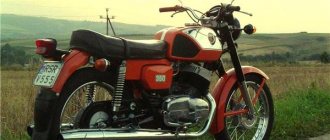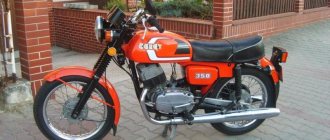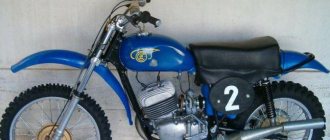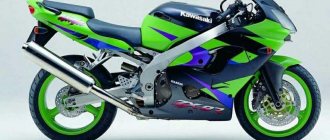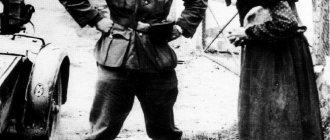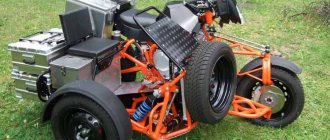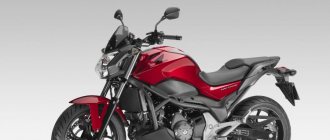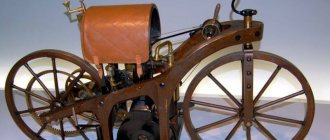Good day to all! I've been thinking about buying Java. Tell me, what is the difference between Java and Chezet?
19 comments were left on this post.
practically nothing. The cheese is a couple of kilos lighter. It has a duralumin pendulum, it’s lighter. That’s basically it
Are they the same in terms of speed and throttle response?
Java 634 and Chezet have the same engine. Quite high-torque. not particularly resourceful
Not all CZ have a duralumin pendulum, many have an iron one similar to those on the JAWA motorcycle
There is an important difference in the frames of the motorcycle: the CZ has one pipe at the front, while the JAWA already has two, which increases its stability.
Java 634 were only 6 volt, but the ChZ with the same engine already had 12 volt electrical equipment, which was later used in the 638 Java engine.
And 6 volts on Java 634 and ChZ 472 are complete crap
In my opinion, the external design of Java is more beautiful than that of ChZ, although I’m not saying that ChZ is not a beautiful spendthrift!
In the photo the ChZ already has 12 volt electrics, but on Java 634 the engine remained 6 volt
Chezet differs from Java in its crankcase, mount, ribs, and drive sprocket; Chezet has one tooth less
Maxim, 6 volts is not a death sentence! The current light is worse than that of 12V, but it’s not inferior to anything! By the way, the Chz has 23 hp and the 634 has 20-22 (depending on the model) and I don’t know how much lighter it is than the Java, it’s 156 kg! The Chz is more maneuverable than the Java, and no less stable, as you say! The design of the frame is made in such a way that even on the contrary, it is less undermined than Java! I’m not just saying, there were 360, 634, 638 and now two Chesets! Yes in the photo there are 12 volts (472.6) but 472.5 (6 volts) are absolutely the same, only tidy with a speedometer and a left cover without a drive on the car! What a good technique!
San, you forgot, in my opinion, the chz 472.5 also has a different pendulum compared to 472.6))
Sanechek, reading your message it’s very nice to understand that the person knows what he’s writing! But about 6 volts, I’ll still argue with you, a 6 volt generator starts to work and only gives charging at crankshaft speeds of at least 1800. What does this mean is that all power supply is provided only from the battery to 1800 revolutions, as a result of which the battery discharges very quickly well that with a discharged battery, the 634 engine can be envyed from a pusher, which cannot be done on a 638 engine, since at least some current is needed to excite the 638 generator.
What kind of motorcycles were there in the USSR?
Czechoslovak cars did not differ as strikingly from their direct domestic competitors - the 350 cc Izh Jupiter with an index of -3, -4 or -5, as the Japanese and German cars of that time did from our Volgas and Moskviches. It cannot be said that motorcycles from Czechoslovakia were more modern (we are talking about the Jawa 634 and CZ 472 generations), but the manufacturing culture and concept were somewhat different. Imported equipment was more comfortable - less noise and vibration, smoother operation of controls, the presence of a tachometer (Jawa) and powerful lighting equipment
Reliable, comfortable and dynamic motorcycles from Czechoslovakia were absorbed by the USSR market by almost 100%. Only a small portion of the annual issue went to other countries, where they had to be advertised.
The Jawa and CZ fared better in terms of performance in real conditions: reliable starting, less frequent ignition and carburetor adjustments were required. The power unit provided dynamics that were brighter than those of domestic cars, not because of greater power (“Izh Jupiter” was just more powerful), but due to the more flexible characteristics of the engine.
The stylish and neat instrument panel of the Java changed the minds of those who had previously driven Izhas, Kovrovtsy and Minsks. There was no tachometer on the CZ.
The disadvantages of “Yav” and “Chezetov” were also common and significant, and the main thing is that they were intended primarily for smooth asphalt roads. And the point here is not only in the lower strength of the suspension parts, but also in the characteristics of the power unit. The operating range of engine speeds and transmission ratios are selected in such a way that the motorcycle shows itself to be most dynamic at high engine speeds and at high speeds.
Motorcycle Java 638 Lux
There are also two main modifications of the motorcycle - Lux and Super. They have an additional designation in the name - 000. Accordingly, the Lux modification received a special shock absorber, thanks to which it was possible to ride a motorcycle with a trailer. To make driving this version as comfortable as possible, the manufacturer installed rubber inserts for the knees and a new, more comfortable seat.
The exterior has also been improved, resulting in a different control panel and muffler. The cylinders on the Java Lux are now placed vertically, which saves space on the motorcycle.
Motorcycle CZ 350 (Chezet 350) – detailed review
This review will focus on a motorcycle that was very popular during the Soviet Union, as well as beyond its borders. The CZ 350 motorcycle (Chezet 350) is a cult bike, which is characterized as reliable transport. The world recognized the Czechoslovakian manufacturer as a reliable supplier of motorcycles, after famous victories in such disciplines as Enduro and Motocross. But, Chezet 350 was rightfully considered a touring motorcycle. It was this unit that made it possible for tourists of that time to discover new horizons.
Production of the CZ 350 type 472.5 began in 1981. The model immediately became relevant among Soviet youth and beyond. This model had noticeable differences from its predecessors, which will be discussed later in the article. The distinctive advantages of the motorcycle are its dynamic performance element and sensitive control system. To appreciate the design of the bike, you need to look at the photo of the Cheset motorcycle. Let's look at the main technical aspects of the motorcycle.
General information
In addition to the USSR, CZ motorcycles found their audience in other countries of the world, primarily due to their technical characteristics and success in motocross and enduro.
It was on Cesete that the Belgian racer Joël Robbert became the world champion, three times – 1964, 1968 and 1969. Also, the make and model of the motorcycle brought third place in the 1964 world championship to Soviet rider Viktor Arbekov. In 1695, he became the first Soviet world champion in motocross.
The history of CZ
The production of this motorcycle began in 1930 at the Česká zbrojovka plant in the Czech city of Strakonice. Previously, this plant produced weapons that had worldwide popularity, primarily due to the quality of work and service life.
The first motorcycle at the plant was created based on the prototype of the German model DKW NZ 350. The first motorcycle, the CZ 350, appeared in 1930, its main purpose was to ride on difficult terrain and rocks. The CZ 350 became the basis for the creation of more advanced motorcycle models. During the Great Patriotic War, the production of motorcycles at the plant was suspended, and the plant returned to the production of weapons.
But motorcycles produced in the pre-war period began to be actively used in combat operations - they delivered weapons, medicine, and food to the battlefield. According to statistics, out of 500,000 motorcycles involved in military operations, only about 200 were completely damaged. Even today, cars produced in Soviet times continue to fulfill their functional duties. After the end of hostilities, the production of motor vehicles within the walls of the plant resumed.
Motorcycle in the USSR
It is worth noting that the CZ 350 was not supplied en masse to the USSR, like, for example, its sister brand Jawa. This is probably why the CZ 350 had a special “foreign charm” and was highly valued among domestic motorcycle enthusiasts. In the USSR, the most popular were the 350 cc models of the 472 family, which were produced in various modifications from 1976 to 1989.
Unlike Java motorcycles, the CZ-350 was sold exclusively as “single” motorcycles, which further contributed to their popularity among young people. In the second half of the 80s, a new Chezet in a wooden box costs 1050 Soviet rubles.
The demand for Chesets was so high that in search of a new motorcycle, motorcyclists could travel halfway across the country to find their Chesets in some motorcycle or sports store. Today, such rarities can be sold for 1,500 euros, primarily due to the fact that in the Soviet years they were practically not used, they were taken more to show off, rarely when the mileage exceeded 2,000 kilometers.
Summary
With identical engines, the main difference between the Jawa and Čezet motorcycles comes down to the chassis. Jawa has a duplex frame designed for use with a stroller, Čezet has a lighter and lower single frame - a stroller cannot be installed on it. It is interesting that during the “Behind the Wheel” tests, the excellent driving characteristics of the Čezet for driving on rural roads and off-road were noted, while the reduced (compared to the duplex Java) frame rigidity of this motorcycle played an important role. Other differences come from different frames and methods of attaching components.
However, the Čezet 472 is not a Java clone; it has its own character, design and handling. The differences between motorcycles are justified; both have the right to respect and their own independent life.
Motorcycles "Chezet"
It’s worth starting by getting to know the Chezet motorcycle as such. What kind of vehicle is this? In fact, everything is quite simple - these are motorcycles of Czechoslovak and then Czech production, which are called that only in Russia. “Chezet” is rather a nickname, because the original name is Česká zbrojovka Strakonice. Naturally, Russian people do not want to use such a name in their everyday speech, so he decided to simplify everything by shortening the name to indicate the country of production, that is, CZ. Well, then, if you pronounce these letters, then you get “Chezet”.
Of course, this was necessary for dictation. Motorcycle owners, who became a public organization led and represented by the Council, could more easily and quickly solve emerging problems and problems, could expect government support or certain incentives for registering vehicles or organizing the departure of Club members for trips abroad. Finally, the club brought together so-called people with common interests and related goals and interests.
About motorcycles and motorcyclists. Despite the fact that the motorcycle was a rather rare, in modern parlance, an exotic car that expresses a lot of noise and arouses interest, admiration or indignation in the literal and figurative sense, it was necessary not only to buy it, which means it had to be quite rich , or love a lot or stubbornly strive to commit to such completely short-lived, unsuspecting and dangerous “investments”. By the way, you had to be able to drive a motorcycle.
This plant has been operating since 1932 and initially concentrated on the production of mopeds. However, he quickly moved on to motorcycles, and in 1935 the first model appeared. Until 1998, the plant operated, producing a wide variety of motorcycles that became popular in Russia. Which Cheset motorcycle do you remember the most? Which was the first and which was the last?
The tradition of cars in society is just beginning to take shape, so it is natural that the motorcycle was attracted to the eye, and its owners were considered heroes or crazy, but they did not focus. The attention was different and deserved. If you need to learn for a couple of months in a car to learn how to ride, this is considered an excellent five-minute salesman's explanation for riding a motorcycle. An interesting and eloquent detail. The article mentions that "disasters" will begin to rise again in the spring. You hear patterns somewhere, right?
This undoubtedly influenced the development and popularity of the motorcycle, as returnees also used this tried and tested technique, most of them in peacetime. On the other hand, it is necessary to evaluate even before the Great War. The same principles that were valid for the production of cars, tricycles and two-wheelers. Thus, in a relatively short time, as throughout the world, motorcycles have become not only a popular car, but also a form of leisure in our country.
Cheset 350: technical characteristics
The main power plant is a two-stroke engine with 2 cylinders. The cylinder arrangement is in-line. The working volume is 343 cc. At the same time, the motor is capable of producing 22 hp. The Port control function was used as a distribution system. The engine receives the necessary cooling due to the oncoming air flow.
The transmission consists of 4 gears. The main transmission is a metal chain. Drum brakes are installed at the front and rear of the motorcycle. Front and rear wheel sizes respectively: 3.25-18 and 3.50-18. The fuel tank is designed for 18 liters of fuel. The motorcycle is capable of reaching a maximum speed of 125 km/h.
Improved appearance and safety
Think about safety first. Standard rims, and even more so drum brakes, are not able to cope with the increased power. It is recommended to install a good disc brake along with replacing spoked rims with alloy wheels. This will not only give a modern look to your bike, but will also significantly improve stability on the track. Accordingly, improved rims from another motorcycle are designed for greater braking force and have normal mounting for the brake disc. Good road tires are also a must.
Replacing headlights and other outdated lighting equipment will appeal to everyone. And the dashboard can be easily transformed by installing LED strip lighting.
The standard steering wheel can be easily replaced with clip-ons or a straight-shaped steering wheel, which will somewhat improve the driver’s aerodynamics due to the inclined seating position. Installing wind deflectors is no longer in fashion, as in Soviet times; they create too much air resistance in front of them. Much preferable is a sports body kit, which, depending on the financial investment, can be picked up from any other motorcycle, but if you really want to make it yourself from fiberglass and epoxy resin. Tuning a Java motorcycle in the photo:
And finally, we want to say that a forced engine requires good 2-stroke oil and timely maintenance. Java tuning is a fascinating activity that requires imagination and direct hands. If you follow the tuning technology, the result will not leave you indifferent
Main differences from previous models
- Spacious fuel tank.
- Upgraded telescopic forks at the front (with black boots).
- Installed safety bars.
- Improved seat.
- Large headlight.
Models type 472.3 and 472.4 were equipped with small-volume gas tanks, which caused a lot of outrage among buyers. These tanks were suitable for sports motorcycles, but not for touring ones. From an ergonomic point of view, the shape of the tank was also unsuitable. The rear part of the tank was wide and caused inconvenience to the owner of the equipment in operation. The upgraded gas tank is designed for 18 liters of gasoline. Its shape has been changed, making travel more comfortable. Regardless of the driver’s configuration, sitting on the motorcycle does not cause discomfort.
Don’t forget about the telescopic fork at the front, which has undergone some changes. The lower pipes are made of light alloy, which in turn only had a positive effect on the price of the fork. Regardless of the operating conditions of the motorcycle, the fork works well both on small uneven surfaces and deep holes, bumps and potholes. In addition, travel has become safer. The fact is that it is very difficult to bring the fork to the bottom, dead-end position. Well, let us remind you about the new rubber covers on the fork, which prevent dust from getting into the middle of the fork. Due to this, the fork will serve for many years.
Description of the classic motorcycle Chezet 350
The first motorcycles appeared in 1930. It was developed by specialists from the city of Czechoslovakia.
This motorcycle was first released from the CZ factory, at that time weapons were manufactured there.
In 1932, the first motorbike was created, which was equipped with a 76 cm3 engine.
In 1933, a cross-country model was released. A 100 cm3 engine was used. After this model, a motorcycle was developed, which was equipped with a 3-speed gearbox and an engine (175 cm3).
In 1936 with 250 cm3. From this model, 2 models were created: - 2 - x cylinder unit with 500 cm3; — 1 — cylinder with 350 cm3.
After the war ended, the production of Cezet motorcycles was resumed. They were produced with a telescopic front fork.
Later a version with rear spark plug suspension was used. In 1950 The production of motorcycles from this company was established.
They were equipped with 2-stroke engines with 123 and 148 cm3. From 1962 to 1965 Java and Chiset were sold on the USSR market. They were very popular at that time.
In 1990, the plant was bought by the Italians. Road motorcycles of 2 types began to be produced: - 2-stroke with 124 cm3 with a Cagiva engine; — 4-stroke with 200 cm3 with CZ engine.
History of the enterprise [edit | edit code]
The small arms production plant in Strakonice was built in 1919 and was originally called Jihočeská zbrojovka
(South Bohemian Arms Factory). In 1922, through a merger with other similar enterprises, a joint stock company arose
Česká zbrojovka v Praze továrny ve Strakonicích
(Czech Arms Factory in Prague, plant in Strakonice). The abbreviation became the company's trademark
CZ
(CheZet).
In the mid-1920s, the company began to develop civilian products, in particular bicycles. In 1929, the first motorbike with a 76 cm³ engine was released, nicknamed Kaktus for its characteristic cylinder shape [3].
Good demand for motorbikes prompted the company's management to further develop this non-core area. In 1934, the company in Strakonice launched the first CZ motorcycle with a single-cylinder two-stroke engine of 172 cm³ on the market. In 1936, the production of more powerful motorcycles with an engine capacity of 250 cm³ was mastered, and in 1938, with an engine capacity of 350 cm³ [3].
In 1946 the plant was nationalized. The production of weapons there was discontinued.
After World War II, the plant mastered the production of new models of motorcycles with a tubular frame and telescopic fork. However, Java became the main enterprise for the production of motorcycles in Czechoslovakia. In this regard, CZ motorcycles were unified with Jawa models and from 1954 to 1959 they were produced under the Jawa-ČZ brand. In 1960, the CZ brand was restored.
In addition to motorcycles Ceska zbrojovka Strakonice
from 1957 to 1964 it produced Čezeta [en] scooters with a single-cylinder two-stroke engine with a volume of 175 cm³. The scooters turned out to be so successful that their production under license was organized in other countries of the world, including in New Zealand under the brand
N-Zeta
.
Specifications
| dry weight | 158 kg |
| with the liquid used | 171 kg |
| lifting capacity | 160 kg |
| engine capacity | 343.3 cm3 |
| bore/stroke | 58*65 |
| working engine power | 23 hp/5250 rpm |
| cooling system | air |
| compression | 1*9* 2 |
| engine | 2-stroke |
| carburetor | Jikov 2926 SBD |
| maximum speed | 132 km/h |
| consumption | 4.7 liters/100 km |
| fuel tank | 13 l |
| oil for box | 1.2 l |
| front fork oils | 0.2 l |
| Motorcycle dimensions | |
| length | 201 cm |
| height | 101 cm |
| width | 71.5 cm |
| transmission | 4 speed |
| brake system | drum |
Modern edition
The modern production of CheZet motorcycles is very diverse. You can purchase a sports or classic type of motorcycle.
These models are produced for driving: amateur and professional.
These motorcycles are made using motors that have increased power and torque. Light weight. You can create fast dynamics during acceleration.
The classic version of CheZet motorcycles is considered to be a model with an engine capacity of 350 cm3. In terms of technical characteristics, these motorcycles are similar to Java motorcycles.
Therefore, many parts of these two brands of motorcycles are interchangeable. In 1973, these 2 companies merged to jointly release.
The most popular and best-selling model of the CheZet motorcycle is the CZ (CheZet) 350 12v.
This model belongs to the tourist class. 23 hp motor. With. A 4-speed gearbox is used. The engine speed is squeezed to the maximum - 5000 rpm.
approximate cost
It is very difficult to talk about a specific price for this device. Everything depends primarily on the condition of the frame and the technical condition of the bike; we must not forget about the availability of all the necessary documents. On the Russian market, the price for this model starts from 10,000 rubles. Motorcycles sold are as early as 1988 or older.
An inspiring video of a Triumph motorcycle; when watching, you can feel the reliability and power of this bike.
A modular helmet for a snowmobile has undeniable advantages for use in winter.
Motorcycles for every taste and budget
Regardless of your purchasing goals and preferences, in our ad service you can purchase:
- used and new motorcycles;
- bright and fast racing models;
- timeless classics from Harley Davidson;
- “workhorses” - cargo motorcycles and models with sidecars;
- Soviet motorcycles - both with a fair amount of mileage and after garage storage.
Advertisements are placed by individuals and business representatives, but prices for OLH in any case are much more pleasant than in car dealerships.
Photo gallery
Introducing the iconic CZ 350, a true legend of its time. There wasn't a single teenager who didn't want to buy this bike. We have made a small selection of photographs especially for you.
